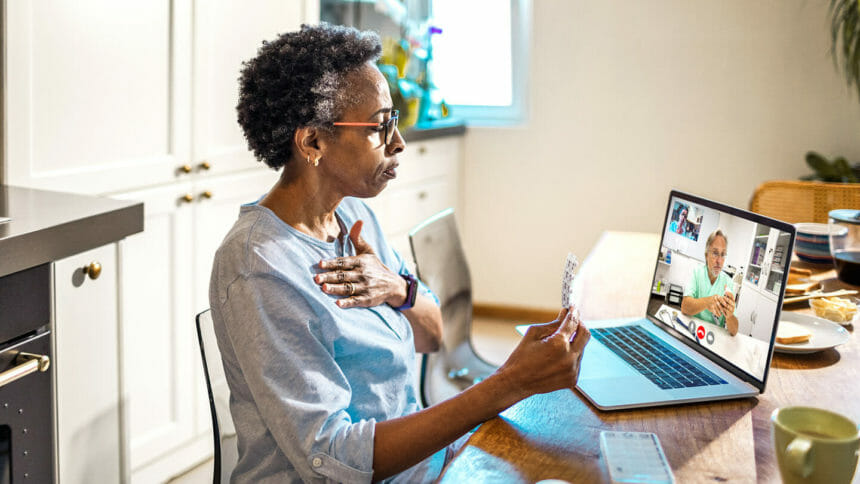
The United States is creating two Americas with its lack of cohesive policy on universal broadband access. That was the sentiment of two panelists during a Monday session of the Department of Health and Human Services’ Telehealth Conference.
Broadband access is “the ultimate social determinant of health,” asserted Ry Marcattilio-McCracken, senior researcher and research team lead with the Institute for Local Self-Reliance’s Community Broadband Networks Initiative.
Marcattilio-McCracken noted that not having access to broadband affects employment, education and healthcare opportunities, and it has an impact on both rural and urban areas. He pointed to a March study in JAMA Network Open that examined the relationship between social determinants of health and COVID-19 mortality rates across racial and ethnic groups, and rural, suburban and urban settings. Those areas that did not have access to the internet fared worse in health outcomes.
“Across all community types, places with limited internet access had higher mortality rates, especially in urban areas,” the study found.
Sascha Meinrath, Palmer Chair in Telecommunications at Penn State and director of X-Lab, a think tank focusing on the intersection of vanguard technologies and public policy, gave a stinging indictment of the federal government’s universal broadband access policy. The government has not collected data on the number of people who don’t have broadband and does not hold accountable entities that misstate where they provide broadband services.
“In terms of national infrastructure, given how crucial broadband activity is … the fact we haven’t developed the plan to ensure long-term broadband to everyone in the country is a rather shocking shortcoming,” he said in his concluding remarks.
Just last week, President Biden disclosed a plan to expand access to high-speed internet to millions of Americans. The American Jobs Plan, the massive infrastructure bill signed into law late last year, contains $65 billion for broadband.
Meinrath and Marcattilio-McCracken offered a sobering perspective on the growth plans. Without baseline data, it will be impossible to maximize the use of the Jobs Plan broadband funds, Meinrath said. He also noted that the program’s budget of $42.5 billion, which individual states will administer under the direction of the Commerce Department, is just a down payment. The cost of providing everyone broadband is closer to $400 billion.
Without a world-class infrastructure, the U.S. is creating a next generation of “haves” and “have nots,” he said.
To make matters worse, some 17 states have placed barriers in front of cities to deploy and run broadband infrastructure, Marcattilio-McCracken added.
PHE and telehealth
Broadband access was one of many topics discussed over the two-day Telehealth Conference, which ended Tuesday. The conference, initiated by the Health Resources and Services Administration, convened stakeholders from across the government, healthcare and academia. Speakers talked about how the pandemic unleashed unprecedented opportunities in telehealth and how the landscape might look moving forward.
“The flexibilities that were enabled through the public health emergency led to a significant growth in telehealth,” Centers for Medicare & Medicaid Services Deputy Administrator Meena Seshamani said during the opening session. She noted that in 2020, telehealth utilization by people on Medicare increased 63-fold to 52.7 million visits.
The strong possibility that the government will extend the public health emergency beyond July offers a lifeline for PHE waivers related to telehealth. CMS already has said that it will permanently extend coverage for behavioral telehealth services. The rule, which was part of the 2022 Physician Fee Schedule, would require patients and providers meet in-person at least six months prior to adopting virtual series and once a year going forward.
Some experts at the conference talked about the need for tweaks to telehealth going forward. For example, Karen Rheuben, M.D., director of telehealth for the University of Virginia, said the requirement of the in-person visit for behavioral telehealth “may be a gigantic challenge for patients and providers.”
The issue of telehealth as it relates to equity came up frequently on Monday.
Damien Doyle, M.D., medical director of Signify Health, pointed out that pulling back from telehealth would create more disparities, particularly in the geriatric population. But Rheuben and Jack Rollins, director of federal policy for the National Association of Medicaid Directors, noted that rural, underserved patients don’t have access to broadband.
“We have to solve for some basic infrastructure,” Rollins said. “If you don’t have access to high-speed broadband internet, you’re not going to get the same kind of potential telehealth experience.”
This article originally appeared on McKnights Home Care




